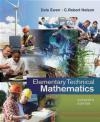- Producent: Brooks/Cole
- Rok produkcji: 2014
- ISBN: 9781285199191
- Ilość stron: 640
- Oprawa: Miękka
Niedostępna
Opis: Elementary Technical Mathematics - Dale Ewen, C. Nelson
Elementary Technical Mathematics Eleventh Edition is written to help students with minimal math background successfully prepare for technical, trade, allied health, or Tech Prep programs. The authors focus on fundamental concepts in basic arithmetic including the metric system and measurement, algebra, geometry, trigonometry, and statistics, which are supported by thousands of examples, exercises, and applications surrounding such fields as industrial and construction trades, electronics, agriculture/horticulture, allied health, CAD/drafting, HVAC, welding, auto/diesel service, aviation, natural resources, culinary arts, business/personal finance, and others. For this revision, the authors have added over 150 new exercises, 30 new examples, new applications categories, and a new appendix on simple inequalities. The goal of Elementary Technical Mathematics is to engage students and provide them with the math background they need to succeed in future courses and careers. 1. BASIC CONCEPTS. Unit1A Review of Operations with Whole Numbers. 1.1 Review of Basic Operations. 1.2 Order of Operations. 1.3 Area and Volume. 1.4 Formulas. 1.5 Prime Factorization Divisibility. Unit 1A: Review. Unit 1B Review of Operations with Fractions. 1.6 Introduction to Fractions. 1.7 Addition and Subtraction of Fractions. 1.8 Multiplication and Division of Fractions. 1.9 The U.S. System of Weights and Measures. Unit 1B: Review. Unit 1C Review of Operations with Decimal Fractions and Percent. 1.10 Addition and Subtraction of Decimal Fractions. 1.11 Rounding Numbers. 1.12 Multiplication and Division of Decimal Fractions. 1.13 Percent. 1.14 Part, Base, and Rate. 1.15 Powers and Roots. 1.16 Application Involving Percent: Business and Personal Finance. Unit 1C: Review. Chapter 1: Group Activities. Chapter 1: Summary. Chapter 1: Review. Chapter 1: Test. 2. SIGNED NUMBERS AND POWERS OF 10. 2.1 Addition of Signed Numbers. 2.2 Subtraction of Signed Numbers. 2.3 Multiplication and Division of Signed Numbers. 2.4 Signed Fractions. 2.5 Powers of 10. 2.6 Scientific Notation. 2.7 Engineering Notation. Chapter 2: Group Activities. Chapter 2: Summary. Chapter 2: Review. Chapter 2: Test. Chapter 1-2: Cumulative Review. 3. THE METRIC SYSTEM. 3.1 Introduction to the Metric System. 3.2 Length. 3.3 Mass and Weight. 3.4 Volume and Area. 3.5 Time, Current, and Other Units. 3.6 Temperature. 3.7 Metric and U.S. Conversion. Chapter 3: Group Activities. Chapter 3: Summary. Chapter 3: Review. Chapter 3: Test. 4. MEASUREMENT. 4.1 Approximate Numbers and Accuracy. 4.2 Precision and Greatest Possible Error. 4.3 The Vernier Caliper. 4.4 The Micrometer Caliper. 4.5 Addition and Subtraction of Measurements. 4.6 Multiplication and Division of Measurements. 4.7 Relative Error and Percent of Error. 4.8 Color Code of Electrical Resistors. 4.9 Reading Scales. Chapter 4: Group Activities. Chapter 4: Summary. Chapter 4: Review. Chapter 4: Test. Chapter 1-4: Cumulative Review. 5. POLYNOMIALS: AN INTRODUCTION TO ALGEBRA. 5.1 Fundamental Operations. 5.2 Simplifying Algebraic Expressions. 5.3 Addition and Subtraction of Polynomials. 5.4 Multiplication of Monomials. 5.5 Multiplication of Polynomials. 5.6 Division by a Monomial. 5.7 Division by a Polynomial. Chapter 5: Group Activities. Chapter 5: Summary. Chapter 5: Review. Chapter 5: Test. 6. EQUATIONS AND FORMULAS. 6.1 Equations. 6.2 Equations with Variables in Both Members. 6.3 Equations with Parentheses. 6.4 Equations with Fractions. 6.5 Translating Words into Algebraic Symbols. 6.6 Applications Involving Equations. 6.7 Formulas. 6.8 Substituting Data into Formulas. 6.9 Reciprocal Formulas Using a Calculator. Chapter 6: Group Activities. Chapter 6: Summary. Chapter 6: Review. Chapter 6: Test. Chapters 1-6: Cumulative Review. 7. RATIO AND PROPORTION. 7.1 Ratio. 7.2 Proportion. 7.3 Direct Variation. 7.4 Inverse Variation. Chapter 7: Group Activities. Chapter 7: Summary. Chapter 7: Review. Chapter 7: Test. 8. GRAPHING LINEAR EQUATIONS. 8.1 Linear Equations with Two Variables. 8.2 Graphing Linear Equations. 8.3 The Slope of a Line. 8.4 The Equation of a Line. Chapter 8: Group Activities. Chapter 8: Summary. Chapter 8: Review. Chapter 8: Test. Chapters 1-8: Cumulative Review. 9. SYSTEMS OF LINEAR EQUATIONS. 9.1 Solving Pairs of Linear Equations by Graphing. 9.2 Solving Pairs of Linear Equations by Addition. 9.3 Solving Pairs of Linear Equations by Substitution. 9.4 Applications Involving Pairs of Linear Equations. Chapter 9: Group Activities. Chapter 9: Summary. Chapter 9: Review. Chapter 9: Test. 10. FACTORING ALGEBRAIC EXPRESSIONS. 10.1 Finding Monomial Factors. 10.2 Finding the Product of Two Binomials Mentally. 10.3 Finding Binomial Factors. 10.4 Special Products. 10.5 Finding Factors of Special Products. 10.6 Factoring General Trinomials. Chapter 10: Group Activities. Chapter 10: Summary. Chapter 10: Review. Chapter 10: Test. Chapters 1-10: Cumulative Review. 11. QUADRATIC EQUATIONS. 11.1 Solving Quadratic Equations by Factoring. 11.2 The Quadratic Formula. 11.3 Applications Involving Quadratic Equations. 11.4 Graphs of Quadratic Equations. 11.5 Imaginary Numbers. Chapter 11: Group Activities. Chapter 11: Summary. Chapter 11: Review. Chapter 11: Test. 12. GEOMETRY. 12.1 Angles and Polygons. 12.2 Quadrilaterals. 12.3 Triangles. 12.4 Similar Polygons. 12.5 Circles. 12.6 Radian Measure. 12.7 Prisms. 12.8 Cylinders. 12.9 Pyramids and Cones. 12.10 Spheres. Chapter 12: Group Activities. Chapter 12: Summary. Chapter 12: Review. Chapter 12: Test. Chapters 1-12: Cumulative Review. 13. RIGHT TRIANGLE TRIGONOMETRY. 13.1 Trigonometric Ratios. 13.2 Using Trigonometric Ratios to Find Angles. 13.3 Using Trigonometric Ratios to Find Sides. 13.4 Solving Right Triangles. 13.5 Applications Involving Trigonometric Ratios. Chapter 13: Group Activities. Chapter 13: Summary. Chapter 13: Review. Chapter 13: Test. 14. TRIGONOMETRY WITH ANY ANGLE. 14.1 Sine and Cosine Graphs. 14.2 Period and Phase Shift. 14.3 Solving Oblique Triangles: Law of Sines. 14.4 Law of Sines: The Ambiguous Case. 14.5 Solving Oblique Triangles: Law of Cosines. Chapter 14: Group Activities. Chapter 14: Summary. Chapter 14: Review. Chapter 14: Test. Chapters 1-14: Cumulative Review. 15. BASIC STATISTICS. 15.1 Bar Graphs. 15.2 Circle Graphs. 15.3 Line Graphs. 15.4 Other Graphs. 15.5 Mean Measurement. 15.6 Other Average Measurements and Percentiles. 15.7 Range and Standard Deviation. 15.8 Grouped Data. 15.9 Standard Deviation for Grouped Data. 15.10 Statistical Process Control. 15.11 Other Graphs for Statistical Data. 15.12 Normal Distribution. 15.13 Probability. 15.14 Independent Events. Chapter 15: Group Activities. Chapter 15: Summary. Chapter 15: Review. Chapter 15: Test. 16. BINARY AND HEXADECIMAL NUMBERS. 16.1 Introduction to Binary Numbers. 16.2 Addition of Binary Numbers. 16.3 Subtraction of Binary Numbers. 16.4 Multiplication of Binary Numbers. 16.5 Conversion from Decimal to Binary System. 16.6 Conversion from Binary to Decimal System. 16.7 Hexadecimal System. 16.8 Addition and Subtraction of Hexadecimal Numbers. 16.9 Binary to Hexadecimal Conversion. 16.10 Hexadecimal Code for Colors. Chapter 16: Group Activities. Chapter 16: Summary. Chapter 16: Review. Chapter 16: Test. Chapters 1-16: Cumulative Review. Appendix A: Tables. Table 1: Formulas from Geometry. Table 2: Electrical Symbols. Appendix B: Exponential Equations. Appendix C: Simple Inequalities Appendix D: Instructor's Answer Key to All Exercises.1. BASIC CONCEPTS. Unit1A Review of Operations with Whole Numbers. 1.1 Review of Basic Operations. 1.2 Order of Operations. 1.3 Area and Volume. 1.4 Formulas. 1.5 Prime Factorization Divisibility. Unit 1A: Review. Unit 1B Review of Operations with Fractions. 1.6 Introduction to Fractions. 1.7 Addition and Subtraction of Fractions. 1.8 Multiplication and Division of Fractions. 1.9 The U.S. System of Weights and Measures. Unit 1B: Review. Unit 1C Review of Operations with Decimal Fractions and Percent. 1.10 Addition and Subtraction of Decimal Fractions. 1.11 Rounding Numbers. 1.12 Multiplication and Division of Decimal Fractions. 1.13 Percent. 1.14 Part, Base, and Rate. 1.15 Powers and Roots. 1.16 Application Involving Percent: Business and Personal Finance. Unit 1C: Review. Chapter 1: Group Activities. Chapter 1: Summary. Chapter 1: Review. Chapter 1: Test. 2. SIGNED NUMBERS AND POWERS OF 10. 2.1 Addition of Signed Numbers. 2.2 Subtraction of Signed Numbers. 2.3 Multiplication and Division of Signed Numbers. 2.4 Signed Fractions. 2.5 Powers of 10. 2.6 Scientific Notation. 2.7 Engineering Notation. Chapter 2: Group Activities. Chapter 2: Summary. Chapter 2: Review. Chapter 2: Test. Chapter 1-2: Cumulative Review. 3. THE METRIC SYSTEM. 3.1 Introduction to the Metric System. 3.2 Length. 3.3 Mass and Weight. 3.4 Volume and Area. 3.5 Time, Current, and Other Units. 3.6 Temperature. 3.7 Metric and U.S. Conversion. Chapter 3: Group Activities. Chapter 3: Summary. Chapter 3: Review. Chapter 3: Test. 4. MEASUREMENT. 4.1 Approximate Numbers and Accuracy. 4.2 Precision and Greatest Possible Error. 4.3 The Vernier Caliper. 4.4 The Micrometer Caliper. 4.5 Addition and Subtraction of Measurements. 4.6 Multiplication and Division of Measurements. 4.7 Relative Error and Percent of Error. 4.8 Color Code of Electrical Resistors. 4.9 Reading Scales. Chapter 4: Group Activities. Chapter 4: Summary. Chapter 4: Review. Chapter 4: Test. Chapter 1-4: Cumulative Review. 5. POLYNOMIALS: AN INTRODUCTION TO ALGEBRA. 5.1 Fundamental Operations. 5.2 Simplifying Algebraic Expressions. 5.3 Addition and Subtraction of Polynomials. 5.4 Multiplication of Monomials. 5.5 Multiplication of Polynomials. 5.6 Division by a Monomial. 5.7 Division by a Polynomial. Chapter 5: Group Activities. Chapter 5: Summary. Chapter 5: Review. Chapter 5: Test. 6. EQUATIONS AND FORMULAS. 6.1 Equations. 6.2 Equations with Variables in Both Members. 6.3 Equations with Parentheses. 6.4 Equations with Fractions. 6.5 Translating Words into Algebraic Symbols. 6.6 Applications Involving Equations. 6.7 Formulas. 6.8 Substituting Data into Formulas. 6.9 Reciprocal Formulas Using a Calculator. Chapter 6: Group Activities. Chapter 6: Summary. Chapter 6: Review. Chapter 6: Test. Chapters 1-6: Cumulative Review. 7. RATIO AND PROPORTION. 7.1 Ratio. 7.2 Proportion. 7.3 Direct Variation. 7.4 Inverse Variation. Chapter 7: Group Activities. Chapter 7: Summary. Chapter 7: Review. Chapter 7: Test. 8. GRAPHING LINEAR EQUATIONS. 8.1 Linear Equations with Two Variables. 8.2 Graphing Linear Equations. 8.3 The Slope of a Line. 8.4 The Equation of a Line. Chapter 8: Group Activities. Chapter 8: Summary. Chapter 8: Review. Chapter 8: Test. Chapters 1-8: Cumulative Review. 9. SYSTEMS OF LINEAR EQUATIONS. 9.1 Solving Pairs of Linear Equations by Graphing. 9.2 Solving Pairs of Linear Equations by Addition. 9.3 Solving Pairs of Linear Equations by Substitution. 9.4 Applications Involving Pairs of Linear Equations. Chapter 9: Group Activities. Chapter 9: Summary. Chapter 9: Review. Chapter 9: Test. 10. FACTORING ALGEBRAIC EXPRESSIONS. 10.1 Finding Monomial Factors. 10.2 Finding the Product of Two Binomials Mentally. 10.3 Finding Binomial Factors. 10.4 Special Products. 10.5 Finding Factors of Special Products. 10.6 Factoring General Trinomials. Chapter 10: Group Activities. Chapter 10: Summary. Chapter 10: Review. Chapter 10: Test. Chapters 1-10: Cumulative Review. 11. QUADRATIC EQUATIONS. 11.1 Solving Quadratic Equations by Factoring. 11.2 The Quadratic Formula. 11.3 Applications Involving Quadratic Equations. 11.4 Graphs of Quadratic Equations. 11.5 Imaginary Numbers. Chapter 11: Group Activities. Chapter 11: Summary. Chapter 11: Review. Chapter 11: Test. 12. GEOMETRY. 12.1 Angles and Polygons. 12.2 Quadrilaterals. 12.3 Triangles. 12.4 Similar Polygons. 12.5 Circles. 12.6 Radian Measure. 12.7 Prisms. 12.8 Cylinders. 12.9 Pyramids and Cones. 12.10 Spheres. Chapter 12: Group Activities. Chapter 12: Summary. Chapter 12: Review. Chapter 12: Test. Chapters 1-12: Cumulative Review. 13. RIGHT TRIANGLE TRIGONOMETRY. 13.1 Trigonometric Ratios. 13.2 Using Trigonometric Ratios to Find Angles. 13.3 Using Trigonometric Ratios to Find Sides. 13.4 Solving Right Triangles. 13.5 Applications Involving Trigonometric Ratios. Chapter 13: Group Activities. Chapter 13: Summary. Chapter 13: Review. Chapter 13: Test. 14. TRIGONOMETRY WITH ANY ANGLE. 14.1 Sine and Cosine Graphs. 14.2 Period and Phase Shift. 14.3 Solving Oblique Triangles: Law of Sines. 14.4 Law of Sines: The Ambiguous Case. 14.5 Solving Oblique Triangles: Law of Cosines. Chapter 14: Group Activities. Chapter 14: Summary. Chapter 14: Review. Chapter 14: Test. Chapters 1-14: Cumulative Review. 15. BASIC STATISTICS. 15.1 Bar Graphs. 15.2 Circle Graphs. 15.3 Line Graphs. 15.4 Other Graphs. 15.5 Mean Measurement. 15.6 Other Average Measurements and Percentiles. 15.7 Range and Standard Deviation. 15.8 Grouped Data. 15.9 Standard Deviation for Grouped Data. 15.10 Statistical Process Control. 15.11 Other Graphs for Statistical Data. 15.12 Normal Distribution. 15.13 Probability. 15.14 Independent Events. Chapter 15: Group Activities. Chapter 15: Summary. Chapter 15: Review. Chapter 15: Test. 16. BINARY AND HEXADECIMAL NUMBERS. 16.1 Introduction to Binary Numbers. 16.2 Addition of Binary Numbers. 16.3 Subtraction of Binary Numbers. 16.4 Multiplication of Binary Numbers. 16.5 Conversion from Decimal to Binary System. 16.6 Conversion from Binary to Decimal System. 16.7 Hexadecimal System. 16.8 Addition and Subtraction of Hexadecimal Numbers. 16.9 Binary to Hexadecimal Conversion. 16.10 Hexadecimal Code for Colors. Chapter 16: Group Activities. Chapter 16: Summary. Chapter 16: Review. Chapter 16: Test. Chapters 1-16: Cumulative Review. Appendix A: Tables. Table 1: Formulas from Geometry. Table 2: Electrical Symbols. Appendix B: Exponential Equations. Appendix C: Simple Inequalities Appendix D: Instructor's Answer Key to All Exercises.
Szczegóły: Elementary Technical Mathematics - Dale Ewen, C. Nelson
Tytuł: Elementary Technical Mathematics
Autor: Dale Ewen, C. Nelson
Producent: Brooks/Cole
ISBN: 9781285199191
Rok produkcji: 2014
Ilość stron: 640
Oprawa: Miękka
Waga: 1.28 kg




























